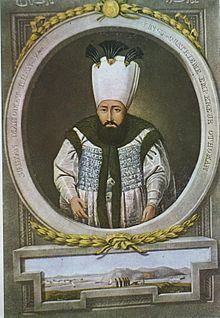Predecessor Ahmed III Royal house House of Osman Name Mahmud I Parents Saliha Sultan, Mustafa II | Successor Osman III Father Mustafa II Role Sultan Siblings Osman III | |
 | ||
Reign 20 September 1730 – 13 December 1754 Consorts Hace Alicenab Kadinefendi
Hace Ayse Kadinefendi
Hace Verdinaz Kadinefendi
Tiryal Kadinefendi
Hatice Rami Kadinefendi
Hatem Kadinefendi
Raziye Kadinefendi
Meyyase Hanimefendi
Fehmi Hanimefendi
Sirri Hanimefendi
Habbabe Hanimefendi Died December 13, 1754, Topkapi Palace, Istanbul, Turkey Cousins Abdul Hamid I, Mustafa III, Sehzade Numan Grandparents Mehmed IV, Emetullah Rabia Gulnus Sultan Similar People Osman III, Mustafa II, Ahmed III, Mustafa III, Abdul Hamid I | ||
Jeweled gun of Sultan Mahmud I, dated 1732-1733
Mahmud I (Ottoman Turkish: محمود اول, Turkish: I. Mahmud, 2 August 1696 – 13 December 1754) was the Sultan of the Ottoman Empire from 1730 to 1754.
Contents
Reign
He was born at Edirne Palace, the son of Mustafa II (1664–1703); his mother was Valide Sultan Saliha Sabkati. Mahmud I was the older brother of Osman III (1754–57).
On 28 September 1730, Patrona Halil with a small group of fellow Janissaries aroused some of the citizens of Constantinople who opposed the reforms of Ahmet III. Sweeping up more soldiers Halil led the riot to the Topkapi Palace and demanded the death of the grand vizer, Nevsehirli Damat Ibrahim Pasha and the abdication of Ahmet III. Ahmet III acceded to the demands, had Ibrahim Pasha strangled, and agreed to his nephew, Mahmud, becoming sultan.
Mahmud I was recognized as sultan by the mutineers as well as by court officials but for some weeks after his accession the empire was in the hands of the insurgents. Halil rode with the new sultan to the Mosque of Eyub where the ceremony of girding Mahmud I with the Sword of Osman was performed; many of the chief officers were deposed and successors to them appointed at the dictation of the bold rebel who had served in the ranks of the Janissaries and who appeared before the sultan bare-legged and in his old uniform of a common soldier. A Greek butcher, named Yanaki, had formerly given credit to Halil and had lent him money during the three days of the insurrection. Halil showed his gratitude by compelling the Divan to make Yanaki Hospodar of Moldavia. However, Yanaki never took charge of this office.
The Khan of the Crimea assisted the Grand Vizier, the Mufti and the Aga of the Janissaries in putting down the rebellion. On 24 November 1731, Halil was strangled by the sultan's order and in his presence, after a Divan in which Halil had dictated that war be declared against Russia. His Greek friend, Yanaki, and 7,000 of those who had supported him were also put to death. The jealousy which the officers of the Janissaries felt towards Halil, and their readiness to aid in his destruction, facilitated the exertions of Mahmud I's supporters in putting an end to the rebellion after it had lasted over a year.
The rest of Mahmud I's reign was dominated by wars with Persia, Austria and Russia.
Mahmud I entrusted government to his viziers and spent much of his time composing poetry.
He died at Topkapi Palace, Constantinople.
Relations with the Mughal Empire
Nader Shah's devastating campaign against the Mughal Empire, created a void in the western frontiers of Persia, which was effectively exploited by the Ottoman Sultan Mahmud I, who initiated the Ottoman-Persian War (1743–1746), in which the Mughal Emperor Muhammad Shah closely cooperated with the Ottomans and their ambassador Haji Yusuf Agha, these relations between the two great empires continued until Muhammad Shah's death in 1748.
